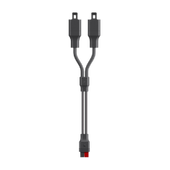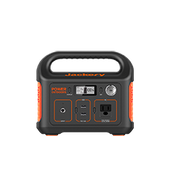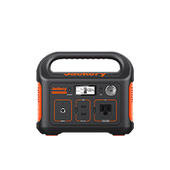Moving into your first or a new house means you need to buy yourself a lot of new appliances, including a dryer. And with this comes the question of how many amps a dryer uses. A typical household dryer uses anywhere between 7.5 and 30 amps and is typically connected to a 240-volt outlet in the United States.
There are plenty of dryers on the market, each in different sizes, models, and capacities. These variations also come with differences in their amperage and wattage, but what do these terms mean? How do you know which dryer is right for your needs and budget? This guide will give you all the information you need on the subject.
If you live in a place with many power outages, you must invest in some power backup. Jackery Solar Generators are a reliable and versatile option that you can consider. You can use these solar generators safely indoors as they’re fume-free and whisper quiet.
Key Takeaways
- A traditional clothes dryer uses between 7.5 to 30 amps of power and consumes about 1500-5000W.
- While clothes dryers run on a 240V system, hair dryers can run on a 120V system.
- You can check your dryer’s amperage in several key ways: check the manufacturer’s details, use a power meter, or determine the amps from the dryer’s wattage.
- Jackery Solar Generators are a reliable power backup solution that can run 99% of your household’s appliances, including a dryer.
How Many Amps Does a Dryer Use?
As the introduction mentioned, a household dryer typically uses anywhere between 7.5 and 30 amps of power. In terms of their wattage, they can consume anywhere between 1,500 - 5,000 watts of power. The exact amperage and wattage will depend on a few different factors, including:
- Size and Capacity:The dryer’s size and capacity will impact its amperage and wattage. A larger dryer will draw more power and run at a higher amperage.
- Features:The dryer's features will also impact its amperage. The more features you use, such as extended drying cycles, air drying, and so on, the more amps it will use. On the other hand, an Eco mode or a quick dry mode will result in the dryer using fewer amps.
However, before we dive deeper into the intricacies of a dryer's amperage, you must understand some key terms, including amps, watts, and volts. These are explained in the forthcoming subsections.
Amp (Amperage): Amps, short for amperes, refers to the amount of electrons flowing through a circuit at any given time. It’s denoted by the letter ‘A.’
The formula to calculate amps is given below:
Amps = Watts / Volts
Watts (Wattage): A dryer’s wattage, or that of any other appliance, refers to the amount of electricity it consumes to make the appliance work. It is calculated as a product of volts and amps and is denoted by the letter ‘W.’
The formula to calculate wattage is as follows:
Watts = Volts x Amps
Volts (Voltage): Volts, short for voltage, refer to the pressure pushing the electrical current through a wire or a circuit. In other words, it refers to the speed at which electrons move through a circuit. Homes in the US typically have 120 or 240-volt electrical systems. The volts are denoted by the letter ‘V.’
The formula to calculate volts is as follows:
Volts = Watts / Amps
You can check out our detailed guide if you want more information about volts, amps, and watts.
How Many Amps Does a Top Load and Front Load Dryer Use?
When you’re in the market for a dryer, you’ll find it usually comes in two formats: top-load and front-load. However, you’ll also come across ventless, gas dryers, and washer-dryer combos. Additionally, you’ll notice that they come in different capacities. As a result, they have different wattages and amperages, which means that they consume different amounts of power.
The table below offers a detailed breakdown of these different dryers in a few popular capacities so you know what kind of electrical system you’ll need to support the dryer of your choice.
|
Dryer Types and Capacity |
Dryer Wattage |
Actual Energy Usage (Around 80% of Dryer wattage) |
Amps (= Watts / 120 Volts) |
Amps (= Watts / 240 Volts) |
|
Top Load Electric Dryer (7.8 cu ft) |
4800-6000W |
3840-4800W |
/ |
20-25 amps |
|
Front Load Electric Dryer (8.1, 8.3 cu ft) |
5000-6000W |
4000-4800W |
/ |
20-25 amps |
|
Ventless Dryer (7.8 cu ft) |
1400-1600W |
1120-1280W |
/ |
5-6 amps |
|
Gas Dryer |
1800-3000W |
1440-2400W |
/ |
7.5-12,5 amps |
|
Washer Dryer Combo |
1500-3000W |
1200-2400W |
/ |
6.25-12.5 amps |
|
Hair Dryer |
1500-2000W |
1200-1600W |
12.5-16.6 amps |
/ |
Note: Depending on the brand and size, the actual energy usage of a dryer might vary from the mentioned 80%.
How Many Amps Does a Dryer Draw on Startup?
The average electric dryer will draw around 6750W on startup, translating to an amperage of around 28.1A.
This is calculated using the following formula:
Amps = Watts / Volts = 6750W / 240V = 28.1A
Once the washing machine starts running, its wattage will reduce to around 5400W and run at 22.5A. This shows that a dryer consumes comparatively more energy upon startup than it does when it’s running. However, this won’t have any realistic impact on your electricity bills as the increased startup wattage is only consumed for a few seconds.
Startup Watts vs. Running Watts
The startup watts refer to the amount of energy needed to start running the dryer from idle. As per the information provided above, the startup watts typically add about 20-25% to the appliance’s running watts. In the example, you can see that the running wattage of the average dryer is 5400W, whereas the startup wattage is 6750W.
To understand this better, let’s consider a household dryer that runs on a 240-volt system and draws about 20 amps of power.
Running Wattage = Voltage x Running Amps = 240 x 20 = 4800W
Startup Wattage = Running Watts x 1.25 = 4800 x 1.25 = 6000W
You should check the manufacturer’s details or the dryer’s user manual to understand its startup and running wattage.
Startup Amps vs. Running Amps
In the same manner that a dryer’s startup wattage is higher than its running wattage, its startup amps will be higher than its running amps. This is because it will use more power to start running from idle. The initial spike then stabilizes after the dryer has started running normally.
To calculate how many amps an electric dryer uses on startup, you can use the following formula:
Startup Amps = Startup Watts / Volts = 6000W / 240V = 25A
How to Calculate Your Dryer’s Amps
Calculating your appliances' amps is important if you want to understand how much electricity they consume. There are three main ways to calculate your dryer's amps so you know if it’s running in optimum condition and needs maintenance.
Method 1: Check the Manufacturer Details or the Energy Star Rating
The easiest way to determine how much electricity your dryer will consume is to check the manufacturer’s details, which are usually provided on a label at the back of the appliance. If you need more information, you can also check the product page on the brand’s website.
Additionally, most modern appliances come with an Energy Star rating, which tells you how efficient the appliance is. You can refer to this for more information. This increased efficiency helps cut down on your electricity bills.
Method 2: Determine the Amps From the Wattage
Another way of calculating your dryer’s amperage is to divide the appliance’s wattage by its voltage. As mentioned earlier, the formula to calculate this is:
Amps = Watts / Volts
So, for example, if you have a dryer that consumes 5000W at 240V, you can calculate the amps as: 5000W / 240V = 20.8A
Method 3: Use a Power Meter
A power meter is useful for checking how many amps your dryer uses, whether a hair dryer or a laundry dryer. All you need to do is plug the power meter into the socket to which the dryer is connected and then plug the dryer into the power meter.
This is one of the most accurate ways of checking how many amps your dryer uses, as it also accounts for the appliance’s operating conditions. The power meter will also consider the power fluctuations during normal conditions.
Tips to Save Your Electricity Bill
Dryers can be rather power-hungry when compared to a lot of the appliances in your home. As a result, they can lead to a spike in your electricity bills, especially if you run several rounds of laundry a week. Here are a few tips that can help you cut down on your electricity bills:
- Air dry your clothes as far as possible by hanging them out on a clothesline and letting nature take its course. While this might take slightly more time, it will ensure your clothes last longer.
- Choose an energy-efficient dryer, as these are designed to consume less electricity than those without an Energy Star rating.
- If you can afford the upfront cost of a gas dryer, you should opt for one as it consumes about 30% less electricity than an electric dryer.
- Keep the dryer’s lint traps, vents, and ducts clean, as this enables it to function more efficiently.
- Use a longer cycle with a lower heat setting than a shorter one with a higher one.
Solar Generators for Dryers
If you’re in the market for one of the most well-known manufacturers of solar generators, solar panels, and portable power stations, you should look no further than Jackery. The Jackery Solar Generators combine the Jackery Portable Power Stations and the Jackery SolarSaga Solar Panels.
When you place the panels under direct sunlight, they absorb solar energy from the sun’s rays and convert this into DC electricity. This is then passed through the pure sine wave inverter to convert it to AC electricity. These solar generators have enough capacity to run 99% of household appliances, including hair dryers, laundry dryers, electric grills, and so on.
To find out which solar generator will be ideal for your needs, you can refer to the appliance wattage chart.
Jackery Explorer 2000 Plus Double Kit
The Jackery Explorer 2000 Plus Double Kit is a large-capacity solar generator designed to run appliances like a dryer that are meant to be connected to a 240V socket. It’s a highly portable design you can carry wherever you go. The solar panels can also be folded to make them easy to carry. This kit offers enough capacity to run most of your household appliances. Further, if you intend to use it to run your dryer, you can safely keep it inside your house as it doesn’t emit fumes and is whisper-quiet.

Jackery Solar Generator 2000 Plus
The Jackery Solar Generator 2000 Plus is the brand’s expandable solar generator, offering enough capacity to run appliances that operate at 120V. It features a portable power station with a handle, wheels, and solar panels that can easily fold to carry with you when you’re heading outdoors. It is also versatile, so you can use it indoors to run your hair dryers and other appliances or even outdoors if necessary. Additionally, it can be charged by ultra-fast solar charging or even using a wall adapter, giving you plenty of options to choose from.

|
Jackery Products |
Capacity & Output Watts |
Dryer Running Time |
|
Jackery Explorer 2000 Plus Double Kit (6000W/240V/4kWh) |
Capacity: 4085.6Wh Rated Output: 6000W
|
Top Load Electric Dryer (4800W) = 42 minutes Gas Dryer (2000W) = 1.7H Hair Dryer (1500W) = 2.3H Ventless Dryer (1600W) = 2.1H |
|
Jackery Solar Generator 2000 Plus |
Capacity: 2042.8Wh Rated Output: 3000W |
Gas Dryer (2000W) = 48 minutes Hair Dryer (1500W) = 1.1H Ventless Dryer (1600) = 1H |
FAQs About Dryer Amps
Is a dryer 30 or 50 amp?
Most residential dryers require a 30A circuit breaker, but you can check the manufacturer’s details at the back of the dryer to see what size you need.
How many amps does a 240V dryer use?
Most clothes dryers use between 7.5 and 30A and must be connected to a 240V outlet.
Can you use a 40 amp breaker for a dryer?
A 40A circuit breaker will let unsafe levels of electricity flow through a circuit connected to a dryer that uses 30A. This is why a 30A circuit breaker is ideal, as any amount of current that exceeds this limit causes the breaker to trip to prevent further damage.
Can a dryer run on 20 amps?
While a gas dryer can be used on a 120V, 20A circuit, most electric dryers must be connected to a 240V socket and have an amperage of 30A.
Conclusion
Once you understand how many amps your dryer uses, you’ll know how much electricity you can expect it to consume. However, since different households have different usage patterns, your bills will come down to how much you use your dryer. This guide has explained how many amps a dryer uses when it’s connected to a 240V system and has also offered some of the best alternatives to the traditional electric grid that you can use to run these appliances. If you’re in the market for a reliable battery backup for your home in a place that witnesses frequent blackouts, then you must consider the Jackery Solar Generators. They’re versatile, rugged, and highly reliable.




















































































































Leave a comment